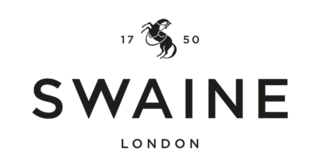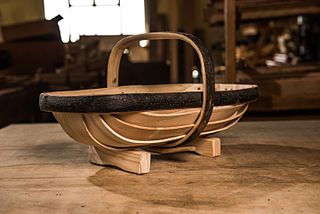
An umbrella or parasol is a folding canopy supported by wooden or metal ribs that is usually mounted on a wooden, metal, or plastic pole. It is designed to protect a person against rain. The term umbrella is traditionally used when protecting oneself from rain, with parasol used when protecting oneself from sunlight, though the terms continue to be used interchangeably. Often the difference is the material used for the canopy; some parasols are not waterproof, and some umbrellas are transparent. Umbrella canopies may be made of fabric or flexible plastic. There are also combinations of parasol and umbrella that are called en-tout-cas.

A staff of office is a staff, the carrying of which often denotes an official's position, a social rank or a degree of social prestige.

A swordstick or cane-sword is a cane containing a hidden blade or sword. The term is typically used to describe Europe weapons from around the 18th century. But similar devices have been used throughout history, notably the Roman dolon, the Japanese shikomizue and the Indian gupti.

A swagger stick is a short stick or riding crop usually carried by a uniformed person as a symbol of authority. A swagger stick is shorter than a staff or cane, and is usually made from rattan. Its use derives from the vine staff carried by Roman centurions as an emblem of office.

Major The Hon. John Wickham Gascoyne Beresford Steed usually known as John Steed, is a fictional character and the central protagonist on the 1960s British spy series The Avengers and its 1970s sequel The New Avengers, played by Patrick Macnee in both; by Donald Monat in the South-African radio series adaptation of The Avengers; by Ralph Fiennes in the 1998 film of the same name and by Julian Wadham in various audio adventures from Big Finish Productions.

Swaine London, known previously as Swaine Adeney Brigg, is one of the oldest names in luxury goods and has traded in London's St James's for over 270 years. The House remains one of the most celebrated and decorated makers and it is the ultimate destination for traditional luxury leather goods, elegant Brigg umbrellas and all sorts of hats from Herbert Johnson.

Whangee refers to any of over forty Asian grasses of the genus Phyllostachys, a genus of bamboos. They are a hardy evergreen plant from Japan, China, and the Himalayas whose woody stems are sometimes used to make canes and umbrella handles. The word derives from the Chinese (Mandarin) huáng lí. It can also refer to a cane made from whangee.

A Sussex trug is a wooden basket. It is made from a handle and rim of coppiced sweet chestnut wood which is hand-cleft then shaved using a drawknife. The body of the trug is made of five or seven thin boards of white willow, also hand-shaved with a drawknife. They may have originated in Sussex because of the abundance of chestnut coppice and willows found on the marshes. Nails or pins used are usually copper, to avoid rust.

J Dixon & Sons, founded 1806 in Sheffield, was one of the major British manufacturers of the Industrial Revolution. They were manufacturers of pewterware, electroplated Britannia metal, silverware and electroplated nickel silver. Their products included hundreds of items for use in the kitchen and the dining room as well as items such as candlesticks. They were a world leader in manufacturing shooting accessories through nineteenth century and exported powder flasks in large quantities to America, They were known as whistle makers, which like most of their products were of outstanding quality; they were one of the 4 great whistle makers, the others being W Dowler & Sons, J Stevens & Son & T Yates.

A walking stick or walking cane is a device used primarily to aid walking, provide postural stability or support, or assist in maintaining a good posture. Some designs also serve as a fashion accessory, or are used for self-defense.
Coloroll is a United Kingdom wallpaper brand owned by CWV Ltd.
The firm of Alexander Mathieson & Sons was one of the leading makers of hand tools in Scotland. Its success went hand in hand with the growth of the shipbuilding industries on the Firth of Clyde in the nineteenth century and the emergence of Glasgow as the "second city of the Empire". It also reflected the firm's skill in responding to an unprecedented demand for quality tools by shipyards, cooperages and other industries, both locally and far and wide.

James Austin is an Australian fine-art and architectural photographer.
Fulton Umbrellas is the United Kingdom's largest manufacturer of umbrellas, used by various members of the British Royal Family.

James Smith & Sons is an umbrella shop in London. The premises in New Oxford Street is Grade II* listed.
Bétaille was a luxury umbrella manufacturer in Paris. The boutique was located at rue Royale 5 from 1880 to 1939. The goodwill and stock of the firm were bought out by Thomas Brigg & Sons in 1919.
Founded in the 1780s, Köhler & Son were independent makers of brasswind instruments in London until they were bought by Swaine & Adeney in 1907.
G. & J. Zair were independent whip-makers founded in the 1830s in Birmingham until they were bought by Swaine & Adeney in 1927.

Herbert Johnson is a London firm of hatters and cap makers. Founded in 1889 at 45 New Bond Street, the business was bought by the London firm of Swaine Adeney Brigg in 1996.
Papworth Industries was the name given to the manufacturing arm of Papworth Village Settlement, a Cambridgeshire colony for sufferers of tuberculosis founded in 1916. The luggage and travel-goods division was bought by the London firm of Swaine Adeney Brigg in 1997.